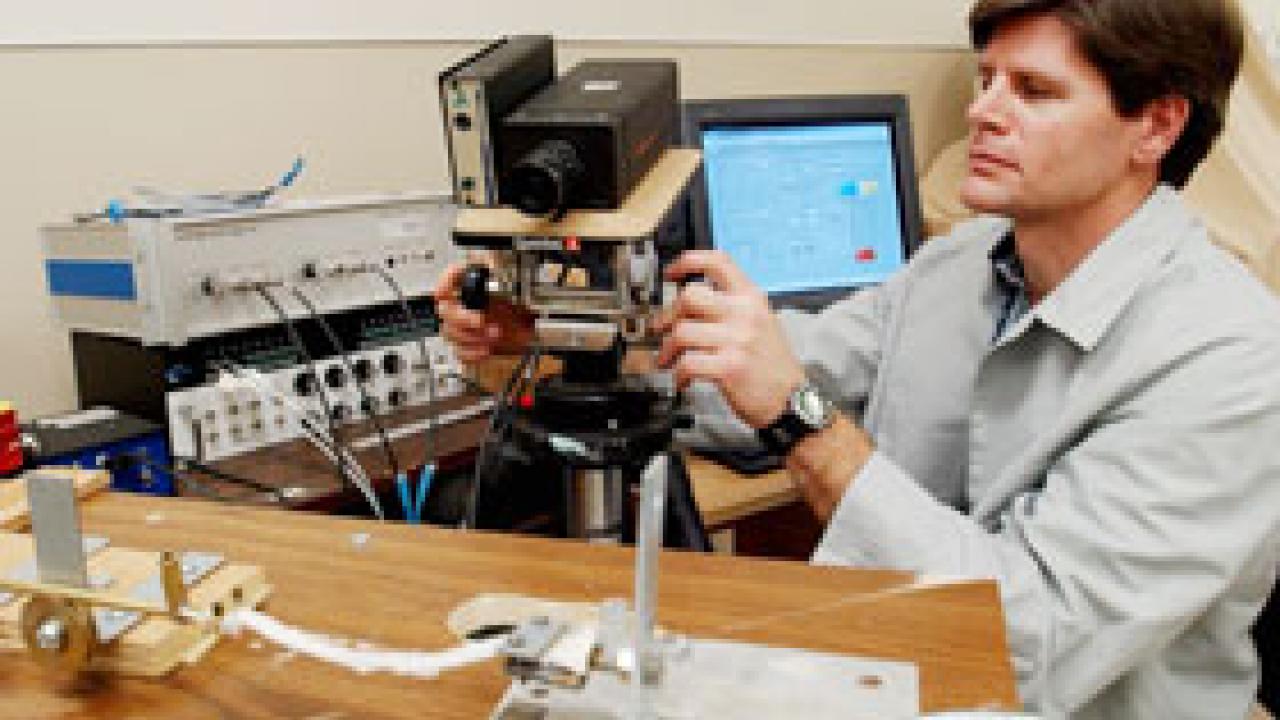Lounge chairs and a TV, a hot tub, treadmills, somewhere to practice your golf swing: it sounds more like a country club than a laboratory, but the Human Performance Laboratory in Hickey Gym is a research tool equipped to measure every aspect of human fitness.
The lab is carrying out basic research to understand human form and function as it relates to physical activity or inactivity, said Dave Hawkins, professor of exercise biology, one of the scientists using the lab.
It's also a teaching lab for students in the exercise biology major, and as a public service, offers a comprehensive health assessment through the Adult Fitness Program, run by lecturers Jim Shaffrath and Robert Holly.
That "TV lounge" is being used by researchers from the USDA's Western Human Nutrition Research Center to study diets based on the concept of limiting carbohydrates, such as the "Atkins," "South Beach" or "Zone" diets. Volunteers are fed meals with different amounts of carbs, fat or protein and then rest for up to 12 hours while researchers track changes in their blood.
In the biomechanics laboratory, strain gauges, nets and video equipment are used to record athletes running, jumping or hitting a golf ball, so researchers can work out how they do it and what they might do better.
"We can measure any muscle in the body and look at the whole body," said facility manager Glen Mangseth.
Hawkins uses the lab's facilities to look at how muscle units are organized and work together to create movement. "We're trying to understand how muscles can work together for force transmission," he said.
Hawkins has applied that research to pediatric wheelchair design, by measuring how much force kids need to generate to push themselves along.
He's also studying how muscles, tendons and ligaments change due to exercise or aging. Muscles build up faster than joints and bones during strength training, a potential cause of injury, he said.
And the "hot tub" is a dunk tank, a big wooden vessel lined with blue plastic and equipped with a chair suspended from a scale. It's used to make an exact measurement of body volume and density. Because fat is less dense than lean body tissue, that can tell researchers the amount of fat in your body.
Measuring density in a dunk tank dates back to Archimedes and is still the gold standard for body composition. But the lab also has some more modern equipment to do the same job without getting wet, such as a total body conductance scanner that can work out the fat content of the body based on how well it conducts electricity in a magnetic field.
The laboratory also has a Dual Energy X-ray Absorbtiometry scanner, for making highly accurate measurements of bone density. It's being used by WHNRC researchers for studies on the bone-weakening condition, osteoporosis.
In the smog room, researchers can take filtered air, add ozone, nitric and sulphuric oxides to brew up smog to order, and see how volunteers perform when breathing tainted air under physical stress. Data collected at the lab helped the California Air Resources Board draw up its guidelines on air pollutants, Shaffrath said. Next door is the environmental chamber, where temperature and humidity can be manipulated to simulate difficult working conditions, for example, for firefighters.
In one case, the program helped get a firefighter who'd become unable to sweat back to work. By testing his heat tolerance, the researchers could set guidelines that kept him at work until he'd made a full recovery.
"Only by doing a comprehensive analysis could we keep him doing his job -- with suitable precautions," Shaffrath said.
Some regional fire and police departments, including UC Davis police and firefighters, routinely use the laboratory for assessing new recruits. Intercollegiate athletics teams use it for fitness and body composition testing.
The Adult Fitness Program's comprehensive health assessment, which takes about three hours in the lab plus keeping a diet diary for three days, includes body composition analysis, blood testing for cholesterol and other components, heart and lung function tests, and recommendations on diet, exercise and preventing heart disease.
The treadmills are a key part of that assessment, putting patients through different levels of exercise while their oxygen consumption and heart rhythms are measured. That gives information about overall fitness and can reveal coronary artery disease.
"We're offering a testing program as part of an overall approach to preventive health management," Holly said. The program carries out about 200 such assessments a year, of which half are internal or research-related and half members of the public.
Shaffrath said that typical external clients would be a couple in their 50s or 60s, approaching or beginning retirement and aiming to stay active, but knowing that they are not as fit as they were.
"They're looking to prevent disease, enhance function, but avoid injuries from over-exercising," Shaffrath said.
And the single best thing you can do to improve your health?
"Turn off the TV," Holly said. "Get off the couch, walk out the front door and don't come back for at least half an hour."
------------------------------Health-smart help offered
In addition to Adult Fitness Program services offered at the human performance lab, services offered by sports medicine experts at the medical center are helping employees evaluate their current levels of fitness and start or maintain exercise programs.
Comprehensive assessments through sports medicine and the performance lab cost approximately $300 and $375, respectively.
For details about the Adult Fitness Program, call (530) 752-2540 or visit http://exercisescience.ucdavis.edu/.
For more about the sports medicine program, call (916) 734-2992 or see http://www.ucdmc.ucdavis.edu/sportsmedicine/.
Media Resources
Andy Fell, Research news (emphasis: biological and physical sciences, and engineering), 530-752-4533, ahfell@ucdavis.edu
